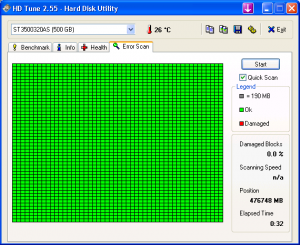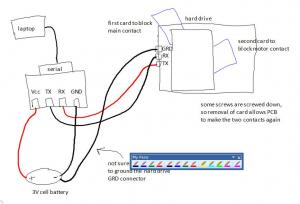
eli2k
MemberAbout eli2k

eli2k's Achievements
0
Reputation
-
Seagate Barracuda 7200.11 Troubles
eli2k replied to Zenskas's topic in Hard Drive and Removable Media
If no one can help you with the cable, I have experience with this board if you can get that or something similar: http://www.schmartboard.com/index.asp?page...lated&id=84 -
The Solution for Seagate 7200.11 HDDs
eli2k replied to Gradius2's topic in Hard Drive and Removable Media
The firmware upgrade is not supposed to affect any of the data. That said, there is a chance something might go wrong. But if you leave the drive on for the time being without turning it off, you should be okay. One reboot should be fine, too, if you have to reboot to install the new hard drive. After I fixed my drive myself and with the help of everyone in the forums, and not Seagate b/c they decided to take a long time to get back to me, I took some of the data I wanted first, and then ran the firmware update. I'm still using the drive today (been about 3 months already), and it's been fine so far. -
The Solution for Seagate 7200.11 HDDs
eli2k replied to Gradius2's topic in Hard Drive and Removable Media
Yep, that is the one I used. USB-serial *should* work, but I did not try it with that method. Hopefully it works? It would be easiest if you could find a friend who has an old computer to try it on. Lots of people hook up power to the board using the PSU cables and taking out the +5V and GND, but I didn't really want to mess with the PSU, so I picked up a 3V battery (the type of battery is on first page) and a battery holder from radioshack, and used this to power the board. Make sure you have the correct screwdriver for the hard drive, too. -
The Solution for Seagate 7200.11 HDDs
eli2k replied to Gradius2's topic in Hard Drive and Removable Media
They have kits that already have the pins soldered onto the board. One board I know of is by SchmartBoard - they sell an RS232-TTL converter board that can be used, hooked up via serial cable. In US, I know it's sold at Fry's and Frys.com. And you just need to pick up jumper cables to connect everything, and soldering is not required at all. So this pathway does not use any of the cell phone cables. - Eli -
The Solution for Seagate 7200.11 HDDs
eli2k replied to Gradius2's topic in Hard Drive and Removable Media
Just the cable isn't going to work; it has to be one of the TTL to RS232 converter chips. I think changing the IO card was not recommended in one of the posts in the thread. -
Post Pictures and Specifications of your computer here!
eli2k replied to ripken204's topic in Hardware Hangout
I love the color coordination! -
The Solution for Seagate 7200.11 HDDs
eli2k replied to Gradius2's topic in Hard Drive and Removable Media
Thanks, that was the problem. Although now i have bigger problem. About hour after unbricking hdd, it started clicking and died. should we do this? i didnt see this info any message in this topic. and my setup is ready but i havent tried anything. wating ur reply. I did my GND using a 3V cell battery. -
Seagate Saga - Issues after firmware update/repair
eli2k replied to sieve-x's topic in Hard Drive and Removable Media
PREVIOUS ISSUE SYMPTOMS: Put into hibernate, brought out of hibernate 1min later, and became BSY. CURRENT ISSUE SYMPTOMS: none LISTED AS AFFECTED: Y REPAIRED: Y METHOD: RS232 controller to send commands to fix it APPLIED WRONG FIRMWARE BEFORE: N UPDATED FW AFTER/BEFORE REPAIR: A PREVIOUS FIRMWARE: SD15 CURRENT FIRMWARE: SD1A EXTERNAL DRIVE (USB/ESATA/1394): N === START OF INFORMATION SECTION === Model Family: Seagate Barracuda 7200.11 Device Model: ST3500320AS Firmware Version: SD1A User Capacity: 500,106,780,160 bytes Device is: In smartctl database [for details use: -P show] ATA Version is: 8 ATA Standard is: ATA-8-ACS revision 4 Local Time is: Sat Feb 21 02:30:14 2009 PST SMART support is: Available - device has SMART capability. Enabled status cached by OS, trying SMART RETURN STATUS cmd. SMART support is: Enabled === START OF ENABLE/DISABLE COMMANDS SECTION === SMART Enabled. === START OF READ SMART DATA SECTION === SMART overall-health self-assessment test result: PASSED General SMART Values: Offline data collection status: (0x82) Offline data collection activity was completed without error. Auto Offline Data Collection: Enabled. Self-test execution status: ( 0) The previous self-test routine completed without error or no self-test has ever been run. Total time to complete Offline data collection: ( 650) seconds. Offline data collection capabilities: (0x7b) SMART execute Offline immediate. Auto Offline data collection on/off support. Suspend Offline collection upon new command. Offline surface scan supported. Self-test supported. Conveyance Self-test supported. Selective Self-test supported. SMART capabilities: (0x0003) Saves SMART data before entering power-saving mode. Supports SMART auto save timer. Error logging capability: (0x01) Error logging supported. General Purpose Logging supported. Short self-test routine recommended polling time: ( 1) minutes. Extended self-test routine recommended polling time: ( 122) minutes. Conveyance self-test routine recommended polling time: ( 2) minutes. SCT capabilities: (0x103b) SCT Status supported. SCT Feature Control supported. SCT Data Table supported. SMART Attributes Data Structure revision number: 10 Vendor Specific SMART Attributes with Thresholds: ID# ATTRIBUTE_NAME FLAG VALUE WORST THRESH TYPE UPDATED WHEN_FAILED RAW_VALUE 1 Raw_Read_Error_Rate 0x000f 110 099 006 Pre-fail Always - 29346917 3 Spin_Up_Time 0x0003 094 094 000 Pre-fail Always - 0 4 Start_Stop_Count 0x0032 100 100 020 Old_age Always - 10 5 Reallocated_Sector_Ct 0x0033 100 100 036 Pre-fail Always - 0 7 Seek_Error_Rate 0x000f 100 253 030 Pre-fail Always - 47028 9 Power_On_Hours 0x0032 100 100 000 Old_age Always - 355 10 Spin_Retry_Count 0x0013 100 100 097 Pre-fail Always - 0 12 Power_Cycle_Count 0x0032 100 100 020 Old_age Always - 144 184 Unknown_Attribute 0x0032 100 100 099 Old_age Always - 0 187 Reported_Uncorrect 0x0032 100 100 000 Old_age Always - 0 188 Unknown_Attribute 0x0032 100 100 000 Old_age Always - 0 189 High_Fly_Writes 0x003a 100 100 000 Old_age Always - 0 190 Airflow_Temperature_Cel 0x0022 075 069 045 Old_age Always - 25 (Lifetime Min/Max 16/25) 194 Temperature_Celsius 0x0022 025 040 000 Old_age Always - 25 (0 14 0 0) 195 Hardware_ECC_Recovered 0x001a 027 022 000 Old_age Always - 29346917 197 Current_Pending_Sector 0x0012 100 100 000 Old_age Always - 0 198 Offline_Uncorrectable 0x0010 100 100 000 Old_age Offline - 0 199 UDMA_CRC_Error_Count 0x003e 200 200 000 Old_age Always - 0 SMART Error Log Version: 1 No Errors Logged SMART Self-test log structure revision number 1 No self-tests have been logged. [To run self-tests, use: smartctl -t] SMART Selective self-test log data structure revision number 1 SPAN MIN_LBA MAX_LBA CURRENT_TEST_STATUS 1 0 0 Not_testing 2 0 0 Not_testing 3 0 0 Not_testing 4 0 0 Not_testing 5 0 0 Not_testing Selective self-test flags (0x0): After scanning selected spans, do NOT read-scan remainder of disk. If Selective self-test is pending on power-up, resume after 0 minute delay. -
The Solution for Seagate 7200.11 HDDs
eli2k replied to Gradius2's topic in Hard Drive and Removable Media
Try a large computer store that sells lots of electronic parts. -
The Solution for Seagate 7200.11 HDDs
eli2k replied to Gradius2's topic in Hard Drive and Removable Media
You can try a loopback test to see if the connection is working. You connect the RX to TX on the cable itself, and once you connect in hyperterminal, anything you type should show up on the screen, indicating you have a working connection. -
Users who recovered their 7200.11 drives
eli2k replied to eli2k's topic in Hard Drive and Removable Media
I'll give the chkdsk command a try. One strange thing, I had copied some files from the Seagate over to another hard drive. Then I unplugged it to put it into another computer. Going back to look at the files I had copied, the folder had become corrupted (?). But I copied them over again and they were fine. -
The Solution for Seagate 7200.11 HDDs
eli2k replied to Gradius2's topic in Hard Drive and Removable Media
Some places (electronic hobby stores) should be selling jumper cables, which you can put onto the end of a wire and have it connect to the pins on the hard drive. -
Are your SMART readings normal? I ran mine through Speedfan and it came back with this one: Hardware ECC Recovered 28 28951300 Watch Warning: Hardware ECC Recovered is below the average limits (33-100). Raw Read Error Rate and Airflow Temperature were slightly in the red zone, too. But I'm not sure what these values are, anyway. Did you all do a complete reformat? I've been running it normally like nothing has happened, after I took the stuff that I wanted back from it onto another drive. - Eli
-
The Solution for Seagate 7200.11 HDDs
eli2k replied to Gradius2's topic in Hard Drive and Removable Media
First board I had from alldav did not work (couldn't do the loopback test so couldn't do anything with it), so I had to pick up the Schmartboard here: http://shop2.frys.com/product/4717389 - hooked it up with 3V cell battery, and disconnected just the motor (the middle connector), and it seems to have worked. -
The Solution for Seagate 7200.11 HDDs
eli2k replied to Gradius2's topic in Hard Drive and Removable Media
Hey guys, is this the correct way to wire everything up? My questions are 1) am I grounding the GND pin from the hard drive properly (is the GND right next to the TX on the hard drive?)? I am going to hook up the SATA power source directly to the drive, and I don't want to stick a ground into there. Someone mentioned that after they connected the SATA power cable, their 3V battery exploded, so I want to be sure this is correct. Are both power sources necessary? It sounds like if I use just the 3V it is enough. If I use just the SATA, then I have to ground it somehow (not sure how). And 2) have I placed the cards in the correct place, to block the motor? I heard there were two areas, the motor and some other part, and both should be blocked off. On the 500gb model I have, there's this little foam cushion thing. I can stick something at the motor (center part), but on the other contact, it becomes difficult, so I'm not sure how to approach this. Thanks, - Eli


